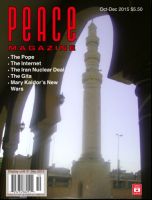
Peace Magazine Oct-Dec 2015, page 25. Some rights reserved.
Search for other articles by Janet Nicol here
Our understanding of First Nations, Métis, and Inuit people in Canada has become an important responsibility as we work to reconcile with our shared collective past and build new relations. An opportunity to begin again is now available since the Truth and Reconciliation Commission (TRC) reported its recommendations in June.
Dating from the 1870s, the Canadian government established church-run Indian Residential schools as a means of assimilating indigenous people to a dominant language and culture. More than 130 boarding and day schools were established across the country, attended by 150,000 students over the ensuing decades, with the last school closing in 1996.
The policy of “killing the Indian in the child” erased cultural knowledge and identity and created alienated parent-child relations, traumatizing generations of aboriginal people. While some students had positive school experiences, many experienced physical, emotional and sexual abuse. These widespread incidents of abuse led to the largest class action suit in Canada.
In 2007 former students settled out of court with the Canadian government and four national churches. One of the terms of the Indian Residential Schools Settlement Agreement was to set up an inquiry into residential schools.
The TRC is unique in that it was court-ordered and supervised and focused on children and youth over a 100-year period. Former students, their families, and communities were invited to speak before the commission, established in June, 2008 and headed by Justice Murray Sinclair, who is of aboriginal background. It is estimated more than 80,000 former students are still living. After collecting testimonies, mostly recorded on videos over a six-year period, the TRC delivered its report and recommendations in June. Their report examines the history, purpose, operation, and supervision of the residential school system, its effect and consequences (including systemic harms, intergenerational consequences and the impact on human dignity), and its ongoing legacy. The TRC also reported on their “Missing Children and Unmarked Graves Project,” which documented the number of deaths of children at the schools, the causes of death, and location of burial grounds. The substantial documentation collected by the TRC has been housed in the University of Manitoba archives for future research, with privacy regulations.
Justice Murray Sinclair concluded that Canada’s residential schools had been an attempt to commit “cultural genocide.” An Angus Reid poll taken in July shows that 70 percent of Canadians agree. This statement is also supported by Supreme Court Chief Justice Beverley McLachlin, who has also described the treatment of aboriginal peoples as the worst stain on Canada’s human rights record.
The TRC has 94 clear and concise “calls to action”—mostly addressed to the federal government-on issues ranging from justice to child welfare. Reading through this highly accessible document reveals much about the inequities and challenges of aboriginal people in Canada. Many of the recommendations are not new, underlining Canada’s lack of progress in redressing aboriginal rights.1 Now non-aboriginal Canadians can contribute to reconciliation in many ways.
Several countries have spoken their truths about past injustices and worked at reconciliation. Now the world will be watching as Canadians take up this vital human rights challenge.
Janet Nicol is a teacher and writer in Vancouver.
1 The full TRC report is online at templatelab.com/truth-and-reconciliation-commission-calls-to-action or through contacting the TRC by webform (www.trc.ca) or email (info@trc.ca).

Peace Magazine Oct-Dec 2015, page 25. Some rights reserved.
Search for other articles by Janet Nicol here